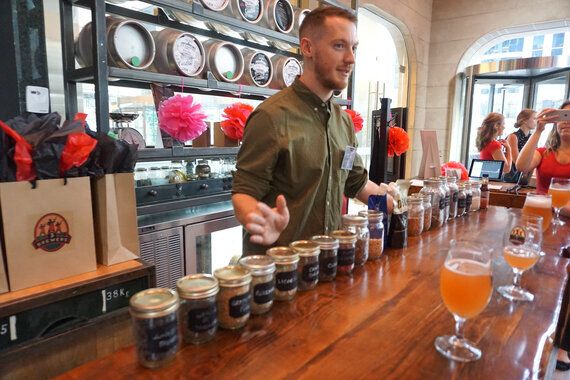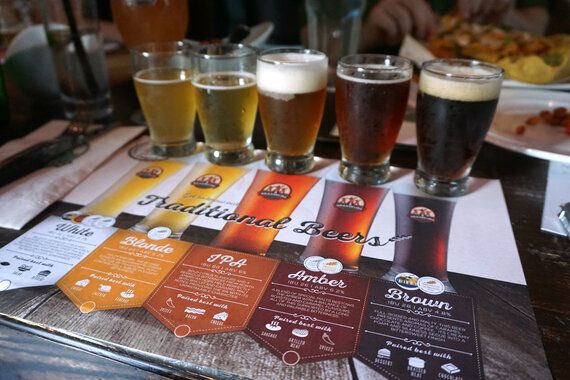Thanks to the craft beer uprising, people are beginning to understand and appreciate the process involved in creating a crisp and refreshing pint; and moreover, that it involves equal amounts of science and creativity.
Although beer will always be considered the more laid-back relative of wine, don't interpret it as code for lacklustre taste. Beer can offer as much complexity as your favourite bottle of wine. And what better way to learn about flavour combinations than with two brewmasters to guide you.
I spoke with Gavin LaForce and Wanis Benzazzouz from Les 3 Brasseurs aka 3 Brewers, to learn about creating delicious suds. The former is in charge of creating brews at the Toronto (Adelaide) location, while the latter oversees all restaurant-breweries in Canada.
One of the unique features at 3 Brewers is Custom Casking. You get to choose your own ingredients to create your very own brew, about 20 litres worth. The entire process takes a about an hour. Then you return in two weeks to taste your creation.
Why choose cask beer/ale?
LaForce explains that the brew is unpasteurized and unfiltered -- which results in fuller, fruitier flavours. You pour in the liquid (along with desired ingredients you want to 'infuse') and sprinkle in the yeast (aka top-fermenting yeast). The carbon dioxide dissolves into the solution (because it has nowhere to escape) -- and creates fizz.
Unlike beer from a bottle or keg, LaForce says that cask carbonation results in light, effervescent champagne bubbles that are fine and soft.
The brewmasters give us a brief rundown of what happens next:
The brew goes through 48 to 72 hours fermentation. Then the cask is placed in the fridge where it sits and ages. During the aging process, the beer clarifies -- this is when the yeast goes to "sleep" and starts sinking out of suspension in the liquid, similar to champagne. When it is ready to drink, the beer gets poured off the yeast and picks up its flavour -- an important characteristic of cask brews. The entire process takes about 2 weeks.
From Hungarian oak to raspberry puree, the variations and combinations of ingredients in cask beer are endless.

But before creating our custom ale, the brewmasters offer us a primer on beer basics and teach us how to pair each type with food.
Traditional Beers at 3 Brewers
These are considered the 'mainstays' of the beer world. Each type offers variations in bitterness (IBU - International Bittering Unit), alcohol content (ABV - Alcohol By Volume), aromas, and flavours.
LaForce and Benzazzouz guide us through the range of beers and although it is perceived that nachos, chicken wings, pizza, fries and other deep fried salty eats reign supreme with these thirst quenching suds, the brewmasters suggest approachable food pairings that can elevate your eating and drinking game.

White
IBU 18, ABV 4.7%
Although it's considered a 'beginner's beer' because it is the mildest of the bunch, don't confuse that for a lack of flavour.
On the Palate: Mild bitterness, citrus, wheat. Light and refreshing.
Food Pairings: The beer is delicate; pair it with lobster rolls (go light on dressing), bruschetta crostini with balsamic drizzle.
Blonde
IBU 24, ABV 5.2%
It's malty and dry and slightly more intense than White.
On the Palate: Crisp, clean. Does not linger on the palate. There's a subtle bitterness that's pleasing.
Food Pairings: Cheese platter (goat cheese and Asiago work really well), grilled chicken skewers with spicy cream sauce.
IPA (India Pale Ale)
IBU 60, ABV 6%
Aggressive bitterness. You either love IPAs or hate them. In fact, the brewmasters note that compared with other IPAs on the market, this one is decidedly more 'tame' than other ones you can find.
On the Palate: Bold bitterness that lingers, back notes of citrus. Aftertaste of biscuit and burnt caramel.
Food Pairings: Panko sausage fritters with sriracha mayo (yes, these are deep fried, but the pork is seasoned with fennel and coated in panko-- which gives the meat loads of flavour and texture), spicy breaded pickles.
Amber
IBU 26, ABV 6.2%
It's a deep bronzed colour and considered more of a dessert beer. Bigger and bolder flavours offered with a touch of bitterness to cut through the sweetness.
On the Palate: Luscious, mellow caramel with a slight bitter edge. Biscuit, light coffee and toffee notes.
Food Pairings: Bacon wrapped steak skewers, grilled button mushrooms.
Brown
IBU 27, ABV 4.8%
Creamy, very malty and rich. Intensely aromatic. Silky on the tongue.
On the Palate: Roundness of dark chocolate, espresso, burnt caramel, finished with bittersweet edge.
Food Pairings: Chocolate brownies, braised beef and stews, crème brûlée.
In light of our tasting, we opted for a blonde beer with seasonal ingredients to celebrate the summer. We chose a blonde beer 'base' and 'steeped' in the following items: Belgian 'candi' syrup, fresh grapefruit peel, pink peppercorn, and raw coconut.
If you created your own beer, what beer 'base' would you select and what ingredients would you add?